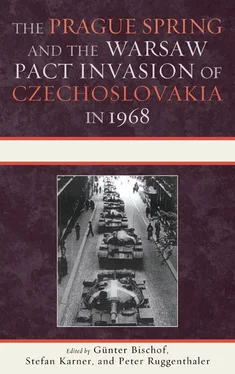Undoubtedly, the Western Communists, while always irredeemably anti–United States from an ideological standpoint, also nurtured ambivalence toward the pluralism of U.S. society. This ambivalence was particularly heightened in the immediate post–World War II period and in the 1960s. The centrality of themes of dissent and the intellectual magnetism for the European Left of characters such as Walt Whitman, Ernest Hemingway, William Faulkner, Jack Kerouac, Bob Dylan, or even contradictory ones such as Marilyn Monroe or James Dean, informed the cultural and political debate among French and Italian Communists, even as they, and particularly when they, confronted themselves with the emerging dissent or antiestablishment developments in Eastern Europe. It is on the intersection between their adaptation to neocapitalism and their continued temptation to rebel against the establishment, whether in the West or the East, that this chapter focuses. The Prague events, together with the student movement, intensified both the French and Italian Communist parties’ dilemma about how best to overcome the Cold War policy and politics of the two blocs that constrained their power: to what extent could they reconcile their effort to become accepted by the establishment with their eagerness for renewal on the Left which embraced rebellion both at home and elsewhere directed toward international socialism? Ultimately this dilemma, if not their whole Cold War experience, was determined more by their cultural and political confrontation with the West than by their issues of allegiance with the East.
According to negative topoi fully formed by the 1920s, modern capitalism, in its managerial, “Americanized” form, subsumed a mechanized world immersed in materialism, consumerism, and mass culture, all together projecting the worst visions of a homogeneous, conformist, spiritually and intellectually hollow society. 2Italian and French Communists, while echoing and amplifying those fears, also portrayed the Soviet model of modernization as the alternative, serving instead of enslaving humanity.
But idealism also meant discerning what both “young countries,” the United States and the Soviet Union, could offer to those whose expression had long been repressed (under Fascist Italy) or stifled (in both France and Italy during the interwar period). From the 1920s onward, that offer consisted of the two emerging superpowers’ nature as dynamic masters of technology, architects of a brave new world distinguished from stagnant, decadent Western Europe. 3That was how PCI founder Antonio Gramsci first analyzed the United States in his essays on Fordism and Americanism: as the place of the most advanced technological and societal experimentation. 4
Youthfulness and informality were also the main strengths of American literature, a powerful response to the elitist, rigid academic nature of Europe’s bourgeois culture. In the words of intellectual and novelist Italo Calvino, to many Western European Communists until the late 1940s, Hemingway was “a sort of God,” and jazz was a “banner of untamed cosmopolitanism.” 5Traveling to the United States in 1946, French Communist author Claude Roy became captivated by the America on the road , where “the individual himself becomes the road,” and where “the road can become a drug, flavorless like marihuana .” America, he added, was a genuine “rebellion of the spirit,” a land of “infinite possibilities.” These possibilities could go either way, for America’s “pride [was] sometimes tragic and menacing,” and “sometimes attractive.” 6For Italian writer Cesare Pavese, America was “an immense theater where our common drama was played out with greater frankness than elsewhere.” Party leader Pietro Ingrao remembered that in the 1930s the American novel “gave us the image of a society where contradictions openly erupted.” 7All these observations displayed far more than fascination with the enemy. They also reflected Communist hopes that the radical, experimental America would prevail over the conservative, philistine, imperialist United States. They were hoping that this vibrant and youthful America would somehow rub off on themselves, too.
The ensuing condemnation of the United States by these same intellectuals was just as revealing. Having nurtured hopes about democratic America, they felt betrayed by the Cold War United States, above all because the “New World” had ceased to be new. Instead of helping to bring liberation to Europe, it imitated and allied itself with Europe’s most conservative, stifling political and cultural elements. Pavese best expressed this disillusion: Americans had turned bad only in part because, in their Cold War retrenchment, they now appeared closer to traditionalist American values; actually, their main fault was that they had “undergone a process of spiritual Europeanization,” losing “a large part of the exotic and tragic directness that was their essence.” 8Thus disenchanted, French and Italian intellectuals were just waiting, if not wishing, to be proven wrong. The United States could, perhaps, again help them spearhead their war against philistine provincialism. Dismissive as leftist thinkers might be in their condemnation of U.S. politics and society, their set of attitudes, especially their reconciliation of subjectivity and social commitment, was bound to make connections with radical thought in the United States, starting from the late 1950s and culminating in the late 1960s. The result would deeply affect the French and Italian Communist parties.
In part, the two superpowers were presumed to “deprovincialize” Europe. What a dream it would be if in the East, too, the contradictions of the human condition were fully displayed, but with the basic difference that, in the East, the oppressed would both express and overcome those contradictions! It would have made the Soviet Union look more human than utopian—utopian with all the meaning of the word, including the dangers associated with being a “brave new world” above human condition. Even before the 20th Congress of the Communist Party of the Soviet Union ( Kommunisticheskaya Partiya Sovetskogo Soyuza or CPSU) and Nikita Khrushchev’s denunciation of Stalinism, members of the PCF and PCI already nurtured the illusion that the Soviet Union was well on its way to perfecting its social and cultural experience through constant debate and open exchange of ideas. The PCI’s Cultural Commission, in its report of November 1953, noticed that while debates on ideology and culture were stalling in the Italian Left, lacking “enough self-criticism,” in the “country where Marxist-Leninist theory has been tempered by thirty years of experience… our comrades liberally and animatedly discuss everything.” On the other hand, the United States, in the throes of McCarthyism, was rapidly “decaying toward authoritarianism.” Indeed, “having ended the common struggle against fascism,” the head of the Cultural Commission, Carlo Salinari, observed, “that is, without the progressive thought embodied in some of its traditions, America, no matter how many skyscrapers, and automobiles, and military [technologies] it produces, will no longer be the vanguard of mass culture. Without its struggle for progress, it will in fact risk surrendering to fascism, even in the name of its best traditions.” 9By 1956, while through de-Stalinization the Soviet leadership was “admitting its own mistakes,” in Italy the Communists had seen no reprieve from McCarthyism, still represented there by the obstreperous U.S. ambassador, Clare Boothe Luce. 10
By the early 1960s, the effects of the “economic miracles” in both countries and the first Marxist analyses of the resilience of neocapitalism somewhat mitigated the Western Communist image of an imperialist and irreparably declining United States. Among French and Italian workers, the prospect of individual, not collective, improvement was now captivating. The working class—and even Communist activists in both countries—craved higher individual living standards. Lotteries were becoming the “new opium of the poor.” Small Fiat or Deux Chevaux Citröen cars, or even the Lambretta scooters may have been poor matches to what U.S. workers could afford, yet even at those modest levels, they were luxuries worth many months of the average Italian or French worker’s paycheck. Nevertheless, their number rose by the millions. Films and television celebrated this newfound freedom and way of life. The PCI’s Giorgio Amendola, who distinguished himself for his economic expertise and political moderation, and Luciano Romagnoli, who directed the party’s propaganda section, were among the first to recognize that “higher standards of living” were “genuine developments toward a more democratic society”; they also felt more compelled than ever to rouse the “workers’ class conscience.” The party, as Enrico Berlinguer exhorted, would not allow “American ideology” and “modernity” to weaken “the sort of political and moral tension, the sort of human spirit without which there cannot be revolutionary action.” 11
Читать дальше












